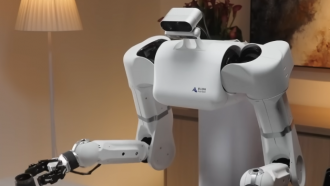Dnsys, a Chinese firm, launches the X1 all-terrain exoskeleton to innovate outdoor activity.
The X1 exoskeleton uses cutting-edge technology to boost natural talents to superhuman levels. This powered marvel makes walking, climbing, and marathoning easier and more efficient, as reported by Fox News. Its impressive 900 watts boost mobility and allow users to carry up to 83 pounds.
With speeds of 16 mph and a small design, the Dnsys X1 will revolutionize outdoor adventure. The 3.5-pound X1 sets a new industry benchmark for lightweight design. Over 100 watts more power than before translates to 18 pounds more load support. The exoskeleton optimizes performance in real-time using motion sensors and AI algorithms.
Imagine moving forward with ease, powered by the Dnsys X1 exoskeleton, while navigating difficult terrain without the strain of bulky packs. Adventurers may travel longer and more comfortably with 50% energy savings.
The X1's push-button turbo mode takes users to 16.7 mph, testing even the most experienced athletes. On the descent, the exoskeleton increases speed, but it also protects the knees and feet. Its hot-swappable batteries, improved energy life, and rapid charging make it ready for lengthy trips.
Lightweight But Strong
Built from aerospace-grade aluminum and carbon fiber, the X1 is strong but light. Its chain clasp belt and Boa dial thigh straps ensure a secure, personalized fit for user comfort and safety.
The Dnsys app makes X1 management easy, updating device states and tracking health parameters instantly. Users may customize their workouts, analyze their progress, and prepare for future challenges.
These technical advances are exciting, but their usefulness in harsh outside conditions is unknown. As more exoskeleton models hit the market, their broad use prompts us to examine human-technology partnerships in nature exploration.
Dnsys' Kickstarter campaign is keenly anticipated. X1 exoskeleton versions range from $399 Lite to $998 Carbon Plus, meeting any adventurer's demands.
Read Also: Essential High-Tech Camping Gadgets for Outdoor Cooking: Here's Why You Need Them
Exoskeleton Tech Set to Change Human Activities Soon
Recently, innovations in exoskeleton technology made headlines recently for their functions that help make strenuous jobs easy and assist individuals who have mobility problems. Researchers have recently demonstrated how a robotic hip exoskeleton can improve stroke patients' walking stride, per UPI.
Researchers found that over 80% of stroke survivors had trouble walking due to a shorter stride on one side. The hip exoskeleton helps people modify their stride by promoting comparable steps in both legs. The hip exoskeleton promotes walking symmetry by powering the hip with the impaired stride and restraining the more competent hip.
Lead researcher Banu Abdikadirova, a mechanical and industrial engineering doctorate candidate at the University of Massachusetts-Amherst, suggests chronic stroke patients might use such a gadget every day. She stresses the need for longer training for walking.
Recent exoskeleton testing on 13 stroke victims shows promise. The gait pattern was more symmetrical, like treadmill training.
Another innovation is the pioneering Apogee+ exoskeleton from German Bionic that helps nurses and other medical personnel reduce physical strain, per an earlier TechTimes report.
This Apogee+ exoskeleton recognizes the stress healthcare personnel, especially those caring for elderly and medically frail patients, face. The Apogee+ supports patient lifting, walking, and treatment placement, with approximately 70 pounds of back relief per lift.
The exoskeleton, with integrated grips for stability and patient repositioning, enables caregivers to provide excellent care while protecting themselves.
Moreover, its lightweight and adjustable design suits it for various healthcare venues and medical professional scenarios.
Related Article: Insect Farmers Leverage AI to Find the Best Methods for Reducing Spending






